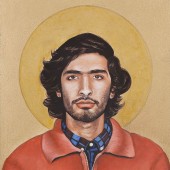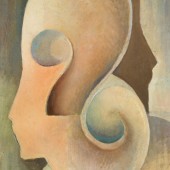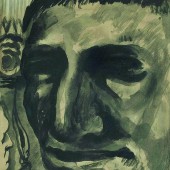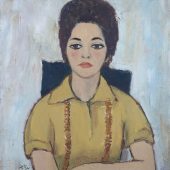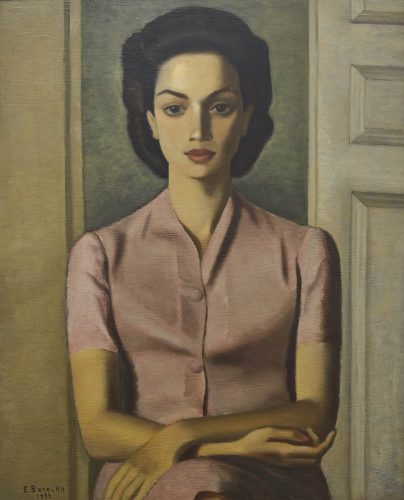
In Portrait de Mademoiselle A.C. is a simplified but stylish portrayal of a woman of the emerging Egyptian middle class. Ezekiel Baroukh’s participation in the Egyptian surrealist group Art et Liberté, and the support of his wife, Annette Fedida, a lawyer and signer of the Degenerate Art Manifesto of 1938, in protest of Fascism in Europe, gives context for this portrait of a woman. With her assured gaze, we may speculate that the woman portrayed here is also an aspiring or accomplished artist and indeed, an intellectual.
In the years before 1948, Baroukh and other Egyptian Jewish artists were well received in intellectual circles in Alexandria and Cairo, where they were joined by exiled intellectuals from Mussolini’s Fascist Italy and by other Europeans who took refuge in Egypt. Baroukh later exhibited The Wounded, whose limbless figure received critical acclaim, and became a motif used by Egyptian Surrealists as a mimesis of state torture and societal constraints. In 1946 Baroukh moved permanently to Paris returning to Egypt in 1954 to exhibit in Alexandria and Cairo. After his return to France, he continued to paint and exhibit until 1984.
تجسد لوحة ” بورتريه الأنسة A.C” صورة بسيطة وأنيقة لامرأة من الطبقة المتوسطة الناشئة في مصر. وتندرج هذه اللوحة ضمن سياق مشاركة باروخ في حركة “فن وحرية”، ودعم زوجته أنيت فيديدا؛ وهي محامية وأحد الموقعين على بيان “يحيا الفن المنحط” لعام 1938، الذي كان احتجاجاً ضد الفاشية في أوروبا. وتوحي النظرات الثاقبة للمرأة في اللوحة بأنها فنانة طموحة ومفكرة بارزة.
وفي السنوات التي سبقت عام 1948، لقي باروخ وغيره من الفنانين اليهود المصريين ترحيباً في الدوائر الفكرية في الاسكندرية والقاهرة، وقد انضم إليهم أيضاً مجموعة من المفكرين المنفيين من إيطاليا الفاشية في عهد موسوليني ومجموعة من الأوروبيين الذين التجأوا إلى مصر. وفي وقتٍ لاحق، عرض باروخ لوحة “الجريح”، وقد حظيت الشخصية المصابة في اللوحة بإشادة النقاد، وأصبحت رمزاً يستخدمه الفنانون السرياليون المصريون ويجسد التعذيب الذي تمارسه الدولة والقيود المجتمعية. وفي عام 1946، اتخذ باروخ من باريس مقراً دائماً له. وفي عام 1954، عاد باروخ إلى مصر ليعرض أعماله في الإسكندرية والقاهرة. وبعد عودته إلى فرنسا مجدداً، استمر في الرسم وعرض أعماله حتى عام 1984.




